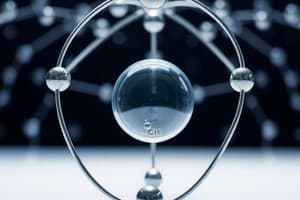Podcast
Questions and Answers
What is the primary focus of organic chemistry?
What is the primary focus of organic chemistry?
- Analysis of chemical processes in living organisms
- Study of inorganic compounds
- Examination of physical properties of chemical systems
- Study of carbon-containing compounds (correct)
Which state of matter has a defined shape and volume?
Which state of matter has a defined shape and volume?
- Liquid
- Plasma
- Gas
- Solid (correct)
What type of bond is formed by the transfer of electrons?
What type of bond is formed by the transfer of electrons?
- Metallic bond
- Hydrogen bond
- Covalent bond
- Ionic bond (correct)
Which of the following best describes a solution?
Which of the following best describes a solution?
What occurs in a synthesis reaction?
What occurs in a synthesis reaction?
Which subatomic particle has a positive charge?
Which subatomic particle has a positive charge?
What is the pH of a typical strong acid?
What is the pH of a typical strong acid?
What does stoichiometry involve?
What does stoichiometry involve?
Flashcards are hidden until you start studying
Study Notes
Introduction to Chemistry
- Definition: The study of matter, its properties, composition, structure, and the changes it undergoes during chemical reactions.
Branches of Chemistry
- Organic Chemistry: Study of carbon-containing compounds.
- Inorganic Chemistry: Study of inorganic compounds, typically not containing carbon.
- Physical Chemistry: Examines the physical properties and behavior of chemical systems.
- Analytical Chemistry: Focuses on the composition of materials and the analytical methods used.
- Biochemistry: Study of chemical processes in biological systems.
Matter and Its Properties
- Matter: Anything that has mass and occupies space.
- States of Matter:
- Solid: Defined shape and volume.
- Liquid: Defined volume, no defined shape.
- Gas: Neither defined shape nor volume.
Atomic Structure
- Atoms: Basic units of matter, composed of protons, neutrons, and electrons.
- Subatomic Particles:
- Protons: Positively charged, found in the nucleus.
- Neutrons: Neutral, also found in the nucleus.
- Electrons: Negatively charged, orbiting the nucleus.
The Periodic Table
- Elements: Pure substances consisting of only one type of atom.
- Groups/Families: Vertical columns with similar chemical properties.
- Periods: Horizontal rows indicating energy levels of electrons.
Chemical Bonds
- Ionic Bonds: Formed by the transfer of electrons from one atom to another.
- Covalent Bonds: Formed by sharing electrons between atoms.
- Metallic Bonds: Bonds between metal atoms where electrons are shared freely.
Chemical Reactions
- Reactants and Products: Reactants undergo transformation to form products.
- Types of Reactions:
- Synthesis: A + B → AB.
- Decomposition: AB → A + B.
- Single Replacement: A + BC → AC + B.
- Double Replacement: AB + CD → AD + CB.
- Combustion: Hydrocarbon + O₂ → CO₂ + H₂O.
Stoichiometry
- Definition: The calculation of reactants and products in chemical reactions.
- Molar Mass: Calculated by adding the atomic masses of all atoms in a molecule.
Acids and Bases
- Acids: Substances that donate protons (H⁺) in aqueous solution; pH < 7.
- Bases: Substances that accept protons; pH > 7.
- pH Scale: Measures acidity/basicity; scale ranges from 0 to 14.
Solutions and Concentrations
- Solution: A homogeneous mixture of solute and solvent.
- Concentration: Amount of solute in a given volume of solution, often expressed in molarity (M).
Thermochemistry
- Definition: Study of heat changes during chemical reactions.
- Exothermic Reactions: Release heat.
- Endothermic Reactions: Absorb heat.
Kinetics and Equilibrium
- Chemical Kinetics: Study of reaction rates and the factors affecting them.
- Dynamic Equilibrium: When forward and reverse reactions occur at the same rate.
Key Definitions
- Element: A pure substance that cannot be broken down into simpler substances.
- Compound: A substance formed from two or more elements chemically bonded.
- Mixture: A combination of two or more substances that retain their individual properties.
Introduction to Chemistry
- Chemistry examines the composition, structure, properties, and changes of matter.
Branches of Chemistry
- Organic Chemistry: Focuses on carbon-containing compounds.
- Inorganic Chemistry: Deals with compounds typically not containing carbon.
- Physical Chemistry: Investigates the physical properties and behavior of chemical systems.
- Analytical Chemistry: Determines the composition of materials and analyzes methods used for this purpose.
- Biochemistry: Studies chemical processes within biological systems.
Matter and Its Properties
- Matter: Anything with mass that occupies space.
- States of Matter:
- Solid: Fixed shape and volume.
- Liquid: Fixed volume, but no fixed shape.
- Gas: No fixed shape or volume.
Atomic Structure
- Atoms: The fundamental units of matter, composed of protons, neutrons, and electrons.
- Subatomic Particles:
- Protons: Positively charged particles located in the atom's nucleus.
- Neutrons: Neutral particles also found in the nucleus.
- Electrons: Negatively charged particles orbiting the nucleus.
The Periodic Table
- Elements: Pure substances consisting of only one type of atom.
- Groups/Families: Vertical columns on the periodic table, indicating elements with similar chemical properties.
- Periods: Horizontal rows on the periodic table, showing the energy levels of electrons.
Chemical Bonds
- Ionic Bonds: Formed by the transfer of electrons from one atom to another.
- Covalent Bonds: Formed by the sharing of electrons between atoms.
- Metallic Bonds: Bonds between metal atoms where electrons are shared freely.
Chemical Reactions
- Reactants and Products: Reactants are substances that transform into products during a chemical reaction.
- Types of Reactions:
- Synthesis: A combination reaction, A + B → AB.
- Decomposition: A breakdown reaction, AB → A + B.
- Single Replacement: One element replaces another in a compound, A + BC → AC + B.
- Double Replacement: A reaction that involves an exchange of ions between two reactants, AB + CD → AD + CB.
- Combustion: A reaction involving a hydrocarbon and oxygen, producing carbon dioxide and water, Hydrocarbon + O₂ → CO₂ + H₂O.
Stoichiometry
- Definition: The calculation of reactants and products in chemical reactions.
- Molar Mass: The mass of one mole of a substance, calculated by adding the atomic masses of all atoms in a molecule.
Acids and Bases
- Acids: Substances that donate protons (H⁺) in aqueous solution, pH < 7.
- Bases: Substances that accept protons, pH > 7.
- pH Scale: Measures acidity/basicity, ranging from 0 to 14.
Solutions and Concentrations
- Solution: A homogeneous mixture of solute and solvent.
- Concentration: The amount of solute in a given volume of solution, commonly expressed in molarity (M).
Thermochemistry
- Definition: The study of heat changes during chemical reactions.
- Exothermic Reactions: Release heat.
- Endothermic Reactions: Absorb heat.
Kinetics and Equilibrium
- Chemical Kinetics: The study of reaction rates and the factors that influence them.
- Dynamic Equilibrium: A state where forward and reverse reactions occur at the same rate.
Key Definitions
- Element: A pure substance that cannot be broken down into simpler substances.
- Compound: A substance formed from two or more elements chemically bonded together.
- Mixture: A combination of two or more substances that retain their individual properties.
Studying That Suits You
Use AI to generate personalized quizzes and flashcards to suit your learning preferences.




